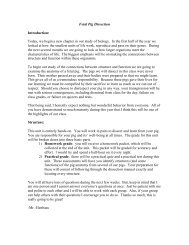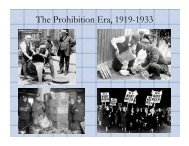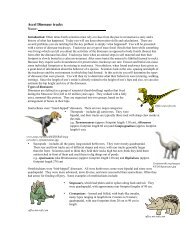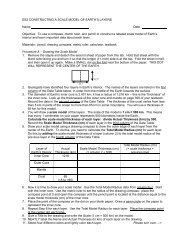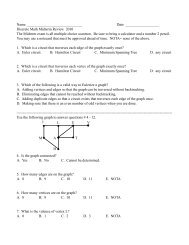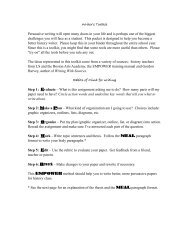Trait Perspective Hans and Sybil Eysenck
Trait Perspective Hans and Sybil Eysenck
Trait Perspective Hans and Sybil Eysenck
You also want an ePaper? Increase the reach of your titles
YUMPU automatically turns print PDFs into web optimized ePapers that Google loves.
<strong>Trait</strong> <strong>Perspective</strong><strong>Hans</strong> <strong>and</strong> <strong>Sybil</strong> <strong>Eysenck</strong>Txai, Charlotte, Ben, Jennifer
Background—History• <strong>Hans</strong> Jürgen <strong>Eysenck</strong>• born March 4, 1916, in Berlin, Germany• moved to Engl<strong>and</strong> in 1930s because opposed Nazi party• 1940 received PhD from the Department of Psychologyat University College London• 1947 wrote book Dimensions of Personality• professor of psychology at the Institute of Psychiatry(part of King’s College London) 1955-1983• died of brain tumor September 4, 1997
Background—Ideas• studied personality using method of factor analysis, a statisticaltechnique introduced by Charles Spearman• believed in two main personality factors, which he described inDimensions of Personality• neuroticism (N)—the tendency to express negative emotions• extraversion (E)—the tendency to enjoy positive events, especiallysocial ones• thought differences in individuals’ behavior determined by relativeprevalence of neuroticism <strong>and</strong> extraversion• high N <strong>and</strong> high E—choleric type• high N <strong>and</strong> low E—melancholic type• low N <strong>and</strong> high E—sanguine type• low N <strong>and</strong> low E—phlegmatic type• studies determined that personality is organized in a hierarchyconsisting of types, traits, habitual responses, <strong>and</strong> specific responses
Theory/Terms• theory based primarily on physiology <strong>and</strong> genetics—interested in temperament• temperament—the aspect of personality that exists from birth• divided personality into two biologically-based categories of temperament:• Extraversion/Introversion• extraversion characterized by being outgoing, talkative, <strong>and</strong> in need of externalstimulation• <strong>Eysenck</strong>'s arousal theory of extraversion—everybody has certain optimal level of arousalat which he/she performs best• extraverts chronically under-aroused <strong>and</strong> need external stimulation to bring them upto an optimal level of performance• introverts chronically over-aroused <strong>and</strong> need peace <strong>and</strong> quiet to bring them to anoptimal level of performance• Neuroticism/Stability• neuroticism or emotionality characterized by high levels of negative affect such asdepression <strong>and</strong> anxiety• neuroticism based on activation thresholds in the part of the brain responsible for thefight-or-flight response• activation can be measured by heart rate, blood pressure, cold h<strong>and</strong>s, sweating, <strong>and</strong>muscular tension• neurotic people, who have low activation thresholds <strong>and</strong> are unable to control theiremotional reactions, experience negative affect in the face of minor stressors• emotionally stable people, who have high activation thresholds <strong>and</strong> good emotional
Theory/Terms• the two dimensions (axes), extraversion-introversion <strong>and</strong> emotional stabilityinstability,define four quadrants:• stable extraverts (sanguine qualities such as outgoing, talkative, responsive,easygoing, lively, carefree, good leaders)• unstable extraverts (choleric qualities such as touchy, restless, excitable,changeable, impulsive, irresponsible)• stable introverts (phlegmatic qualities such as calm, even-tempered, reliable,controlled, peaceful, thoughtful, careful, passive)• unstable introverts (melancholic qualities such as quiet, reserved, pessimistic,sober, rigid, anxious, moody)• further research demonstrated the need for a third category of temperament:• Psychoticism/Socialization• psychoticism associated with aggression <strong>and</strong> liability to have a psychoticepisode• <strong>Eysenck</strong> suggested that psychoticism associated with higher levels oftestosterone
Theory/Terms• table describing traits associated with the three temperaments in<strong>Eysenck</strong>'s model of personality:Psychoticism Extraversion Neuroticismaggressive sociable anxiousassertive irresponsible depressedegocentric dominant guilt feelingsunsympathetic lack of reflection low self-esteemmanipulative sensation-seeking tenseachievement-oriented impulsive moodydogmatic risk taking hypochondriacmasculine expressive lack of autonomytough minded active obsessive
Character Analysis/Terms• Lester Burnham• previously stable extravert—lived a lively <strong>and</strong> carefree life• becomes unstable extrovert as wife <strong>and</strong> job wear him down—becomes restless,impulsive, <strong>and</strong> irresponsible• examples: buys dream car, gets a job with "as little responsibility as possible,"<strong>and</strong> attempts to copulate with his daughter's best friend• Carolyn Burnham• unstable introvert• tries to appear stable by projecting an image of peacefulness (playing quietjazz music at dinner) <strong>and</strong> outward serenity• actually is anxious <strong>and</strong> moody• characteristics polarize as the movie progresses—becomes more outwardlyconfident while further deteriorating internally• example: repeats “I will not be a victim,” while in car holding gun• Jane Burnham• unstable introvert• pessimistic view of life, quiet <strong>and</strong> sober in most social situations• example of pessimism: scene in which Ricky is filming her <strong>and</strong> asking if she
Character Analysis/Terms• Ricky Fitz• stable introvert• even-tempered, controlled, <strong>and</strong> reliable (although some thinkhe seems crazy)—has great control over his emotions• example: scene in which his father beats him <strong>and</strong> kicks himout of the house—Ricky gets angry but stays more collectedthan most people would• Colonel Frank Fitz• unstable introvert• rigid <strong>and</strong> moody• example: beats wife <strong>and</strong> son <strong>and</strong> constantly makeshomophobic statements• fear of people finding out that he is gay makes him overaroused,so making these statements <strong>and</strong> abusing thepeople around him gives him serenity
Character Analysis/Terms• Angela• unstable extrovert• comes off as outgoing, perfect, blond teenager, but actuallyinsecure, restless, <strong>and</strong> irresponsible• examples of impulsivity: tries to insult Jane, declares that theyare not friends anymore, then tries to have sex with Jane'sfather• Buddy• stable extrovert• knows exactly how to take advantage of unstable women• outgoing, talkative, carefree, <strong>and</strong> projects an image ofleadership <strong>and</strong> power• these qualities are attractive, especially to those who lackthem, like Carolyn
Healthy/Unhealthy Personality• emphasis on describing traits as opposed toexplaining behavior, so not too concernedwith healthy vs. unhealthy personality• all personality types are equal• healthy to underst<strong>and</strong> one’s personality socan put oneself in positions to succeed• though some traits (emotional instability,neuroticism) are unhealthy
Detailed Character Analysis• Angela Hayes• extravert, acts confident• favorite world is external—prefers to concentrate on social interactionsrather than occupy herself with internal reflection• trait psychologists use Big Five factors to describe personality(development on <strong>Eysenck</strong>’s three factors of psychoticism, extraversion,neuroticism)• each of Big Five factors exists along continuum, describe personality bywhere the subject falls along continuum• Angela’s Big Five factors:• emotional stability: emotionally unstable• extraversion: extraverted• openness: open• agreeableness: disagreeable (only concerned with her owndesires)• conscientiousness: unconscientious (doesn’t think aboutconsequences of her actions on others)
Detailed Character Analysis• Angela Hayes (continued)• personality doesn’t develop throughout movie—traitperspective focused on enduring personality characteristics• debate about whether behavior is a result of personality orspecific environment• trait psychologists assert that, while the situation doesinfluence behavior, a person’s traits remain largely consistentthroughout his/her life <strong>and</strong> in varying situations• scores of individual’s personality tests taken seven yearsapart correlate fairly well, especially in older subjects• Angela’s consistent extraverted <strong>and</strong> bold behavior indifferent situations (with Angela, Ricky, Lester) supportstrait perspective
Detailed Character Analysis• Angela Hayes (continued)• trait perspective not focused on explainingbehavior• biologically, extraverts have low brain arousal,which causes them to seek external stimulation,<strong>and</strong> a less active frontal lobe• frontal lobe not involved in making decisionto flirt with Lester—not thinking aboutimplications of her actions on Jane, Lester,herself, Carolyn, <strong>and</strong> everyone else



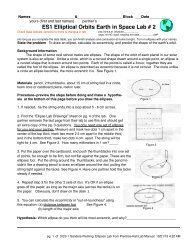


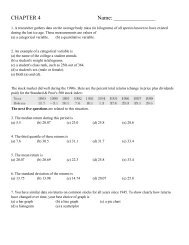

![';1asAu ro; las I sgeo8 leuo!]eslanuol aql utelqo o1 palenttouJ ue I ...](https://img.yumpu.com/49072782/1/190x221/1asau-ro-las-i-sgeo8-leuoeslanuol-aql-utelqo-o1-palenttouj-ue-i-.jpg?quality=85)

